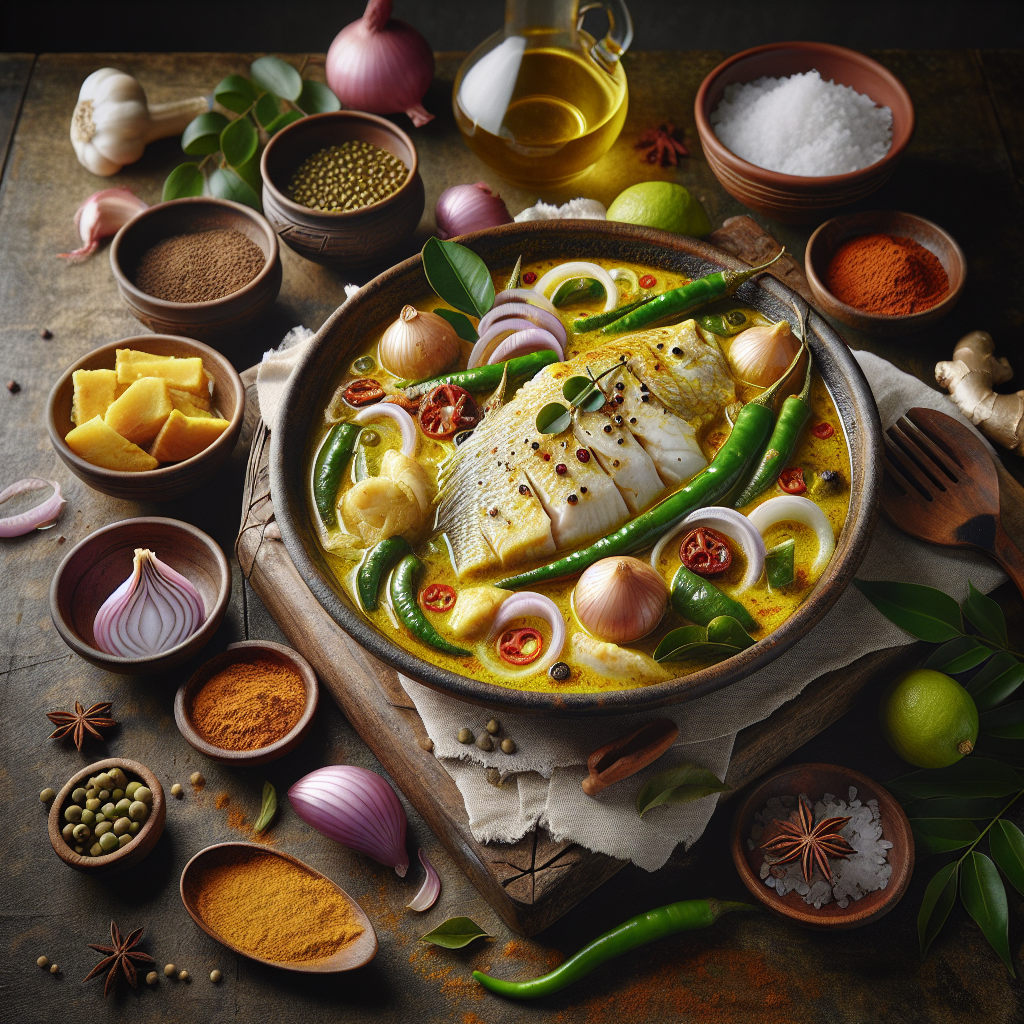
Transport your taste buds to the coastal regions of Kerala with this aromatic fish curry. Made with fresh turmeric root, coconut milk, and fragrant spices, this curry perfectly balances rich, tangy, and spicy flavors. It's a restaurant-quality dish you can easily create at home.
Ingredients for Authentic Kerala Fish Curry with Fresh Turmeric and Coconut Milk
- 21oz White Fish Fillets (Cod or Haddock)
- 1oz Fresh Turmeric Root
- 0.9oz Fresh Ginger
- 4 cloves Garlic Cloves
- 3 whole Shallots
- 2 whole Green Chilies
- 15leaves Curry Leaves
- 14oz Coconut Milk
- 1 tsp Mustard Seeds
- 2 tsp Ground Cumin
- 2 tsp Ground Coriander
- 2 tbsp Tamarind Paste
- 3 tbsp Vegetable Oil
- 1.5 tsp Salt
Instructions for Authentic Kerala Fish Curry with Fresh Turmeric and Coconut Milk
- Cut 21oz fish fillets into large chunks and season with 0.5 tsp salt
- Finely chop 1oz fresh turmeric, 0.9oz ginger, 4 cloves garlic cloves, 3 whole shallots, and 2 whole green chilies
- Heat 2 tbsp vegetable oil in a large pan over medium heat. Add 1 tsp mustard seeds and cook until they start to pop
- Add the chopped aromatics and 15leaves curry leaves. Sauté for 3-4 minutes until fragrant
- Add 2 tsp ground cumin and 2 tsp ground coriander. Cook for 1 minute
- Pour in 14oz coconut milk and 2 tbsp tamarind paste. Bring to a simmer
- Add the fish chunks and remaining 1 tsp salt. Cook for 8-10 minutes until fish is cooked through
- Drizzle remaining 1 tbsp oil over the curry and serve hot
A Journey Through Kerala's Coastal Flavors: Introducing an Authentic Fish Curry
There's something magical about the way a Kerala Fish Curry comes together - the moment those mustard seeds begin their merry dance in hot oil, releasing their nutty aroma, you know you're in for something special. This particular recipe, featuring fresh turmeric root and creamy coconut milk, is a beautiful representation of South Indian coastal cuisine that I've grown to cherish deeply. Ready in under an hour, this curry strikes the perfect balance between rich and tangy flavors, while fresh turmeric adds both color and earthy depth that powder simply can't match.
What makes this Kerala Fish Curry truly special is its authenticity. Each ingredient plays a crucial role - from the curry leaves that add a subtle citrusy note to the tamarind paste that provides that characteristic tang. Whether you're using cod or haddock (both work beautifully here), the fish becomes incredibly tender as it gently simmers in the aromatic coconut sauce, absorbing all those complex flavors we've built layer by layer.
Tips for Perfect Kerala Fish Curry Every Time
The secret to an outstanding Kerala Fish Curry lies in the details. First, don't skip the fresh turmeric - while powder can work in a pinch, fresh root provides an incomparable brightness and complexity. When handling it, wear gloves or be prepared for yellow-stained fingers!
Temperature control is crucial here. When you're blooming the mustard seeds, make sure the oil is hot enough that they pop within 30 seconds, but not so hot that they burn. This initial step sets the foundation for all the flavors to follow.
For the fish, try to cut your pieces uniformly, about 2 inches (5 cm) each, to ensure even cooking. A gentle simmer is key - we want to cook the fish through without breaking it apart. If the curry looks too thick, don't hesitate to add a splash of water, but remember that coconut milk tends to thicken as it reduces.
Serving Your Kerala Fish Curry with Style
This curry truly shines when served steaming hot, with the final drizzle of oil creating beautiful golden pools on the surface. Traditionally, it's paired with Kerala red rice, but basmati rice works wonderfully too. For a complete South Indian experience, serve it alongside some crispy papadams and a simple cucumber raita to balance the heat.
If you're serving guests, consider garnishing with extra curry leaves (quickly fried until crisp) and thin slices of green chilies for those who enjoy an extra kick. The curry keeps well in the refrigerator for up to 2 days, and many say it tastes even better the next day as the flavors continue to develop.
From My Kitchen to Yours: A Personal Kerala Connection
My first encounter with Kerala Fish Curry was during a culinary tour through South India, where I had the privilege of learning from a home cook in Fort Kochi. Her kitchen was modest, but the aromas that filled it were anything but. She taught me that the key to this dish isn't just in the ingredients, but in the patience to let each layer of flavor develop.
What struck me most was how she would taste the curry at every stage, adjusting the balance of sour, spicy, and rich elements until it was just right. She shared that this recipe had been passed down through generations in her family, each cook adding their own subtle touches while maintaining its soul.
Now, whenever I make this curry in my own kitchen, I'm transported back to that humid afternoon in Kerala, watching the fishing boats return with their daily catch as the aroma of fresh turmeric and curry leaves filled the air. It's more than just a recipe - it's a piece of Kerala's rich culinary heritage that I'm honored to share.
Flexible Substitutions for Your Kerala Fish Curry
While traditional Kerala Fish Curry shines brightest with its original ingredients, I understand that some components might be challenging to find. Here are some practical substitutions that maintain the curry's authentic essence:
For the fish:
- Any firm white fish works well. While cod or haddock are ideal, you can use halibut, pollock, or even mahi-mahi
- In a pinch, salmon can work, though it will alter the traditional flavor profile
For the aromatics:
- Fresh turmeric can be replaced with ground turmeric (use 1 tablespoon)
- If curry leaves are unavailable (they're quite unique!), try a combination of lime zest and basil, though the authentic flavor will differ
- Thai bird's eye chilies can substitute for green chilies
- Regular onions can replace shallots (use 1 medium onion)
For the sauce base:
- Light coconut milk works, but full-fat provides the best texture and flavor
- Tamarind paste can be substituted with 2 tablespoons of lime juice plus 1 teaspoon of brown sugar
- If you can't find fresh ginger, use 1 tablespoon of ginger paste
Nutrition Facts: A Healthy Balance of Flavors
This Kerala Fish Curry isn't just a feast for your taste buds - it's also packed with nutritional benefits. Per serving (based on 4 servings):
- Calories: 385
- Protein: 32g (perfect for muscle maintenance)
- Fat: 28g (mostly healthy fats from coconut milk)
- Carbohydrates: 8g
- Sugar: 3g
The curry features several nutritional highlights:
- White fish provides lean protein and essential omega-3 fatty acids
- Fresh turmeric offers powerful anti-inflammatory properties
- Coconut milk contains medium-chain triglycerides (MCTs)
- Spices like cumin and coriander aid digestion
- Fresh ginger and garlic boost immune function
Allergy Considerations for Kerala Fish Curry
As a chef who takes food safety seriously, here are the key allergens to be aware of:
Primary Allergens:
- Fish (main protein)
- Coconut (from coconut milk)
While this recipe is naturally free from:
- Gluten
- Dairy
- Eggs
- Tree nuts (except coconut)
- Peanuts
- Soy
- Shellfish
For fish allergies:
- Unfortunately, this dish cannot be made fish-free while maintaining its authentic character
- However, firm tofu could work as a protein alternative for a different but enjoyable curry
Smart Storage Tips for Your Kerala Fish Curry
To maintain the freshness and flavor of your Kerala Fish Curry:
Fresh Storage:
- Store in an airtight container in the refrigerator
- Consume within 2-3 days for best quality
- Before reheating, let it come to room temperature for 15 minutes
Freezing Method:
- Can be frozen for up to 2 months
- Store in freezer-safe containers with minimal air space
- Label with date and contents
- Thaw overnight in refrigerator
Reheating Guidelines:
- Gentle heat on stovetop is best
- Add a splash of water or coconut milk if needed
- Stir occasionally while reheating
- Heat until just hot to preserve fish texture
Frequently Asked Questions About Kerala Fish Curry
Can I make this curry ahead of time? Yes, but it's best consumed within 24 hours. The flavors actually develop nicely overnight.
Why is fresh turmeric specified? Fresh turmeric provides a brighter, more complex flavor profile, though ground turmeric can work as a substitute.
Is this curry very spicy? The heat level is moderate. Adjust the green chilies to your preference.
Can I use frozen fish? Yes, just ensure it's completely thawed and patted dry before using.
Why do we drizzle oil at the end? This traditional technique, called "tempering," adds a final layer of flavor and beautiful sheen to the curry.
A Final Note on This Beloved Kerala Fish Curry
As someone who grew up learning both Asian and American cooking traditions, I've always been fascinated by how different cultures create magic with seafood. This Kerala Fish Curry represents the perfect harmony of fresh ingredients, aromatic spices, and time-honored cooking techniques. The combination of fresh turmeric, coconut milk, and perfectly cooked fish creates a dish that's both comforting and exotic.
What makes this curry special is its balance - tangy from tamarind, rich from coconut milk, and warmly spiced without being overwhelmingly hot. It's a testament to Kerala's coastal cuisine, where seafood and spices dance together in perfect harmony. Whether you're an experienced cook or new to Indian cuisine, this recipe offers a delicious gateway into the wonderful world of South Indian cooking. Remember, the key to success lies in respecting the ingredients and taking time to let the flavors develop.
